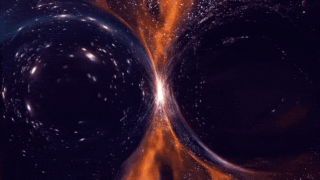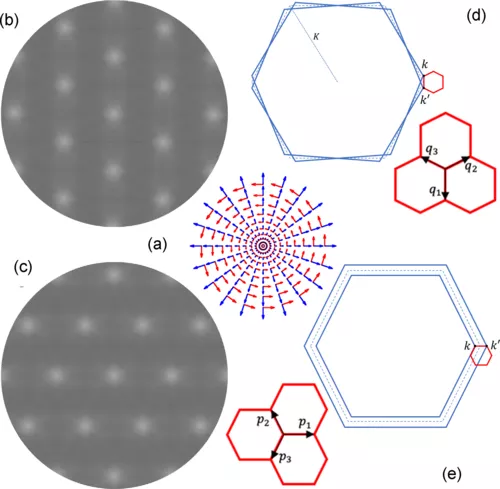Physicists sometimes come up with bizarre stories that sound like science fiction. However, some stories proved to be true. For example, the curvature of space and time described by Einstein was finally confirmed by astronomical measurements. Others are merely as a possibility or mathematical curiosity. In physics review research 》In a new paper, Victor galitski, a researcher at the joint quantum Institute (Jqi) and Alireza parhizkar, a Jqi graduate student, studied the imaginative possibility that our real world is only half of the two interactive worlds**

Their mathematical model may provide a new perspective on the basic aspects of reality - including why our universe expands in this way and how it relates to the smallest length allowed in quantum mechanics. These topics are crucial to understanding our universe and are part of one of the great mysteries of modern physics.
The two scientists came up with this new idea by chance when studying something completely different, that is, the study of graphene sheets. They realized that experiments on the electrical properties of stacked graphene sheets produced results similar to those of the small universe, and that this basic phenomenon could spread to other fields of physics. In stacked graphene, new electrical behavior arises from the interaction between various sheets. Therefore, perhaps unique physics can also appear from the interaction layers elsewhere - perhaps in the cosmological theory of the whole universe.
"We think this is an exciting and ambitious idea," said galitski, who is also the Chesapeake Chair Professor of theoretical physics in the Department of physics. "In a sense, it works so well by naturally 'predicting' the basic characteristics of our universe, such as inflation and Higgs particles, which we describe in subsequent preprints, that it is almost doubtful."
The special electrical properties of stromatolite graphene and the possible connection between stromatolite graphene and our reality come from the special physics produced by the pattern called molar pattern. When two repeating patterns -- from hexagonal atoms in graphene sheets to a grid of window screens -- overlap, and one of the layers is distorted, offset, or stretched, a molar pattern is formed.
The pattern appearing can be repeated over a huge length compared to the underlying pattern. In the graphene stack, the new pattern changes the physical properties of the sheet, especially the behavior of electrons. In the special case known as "magic angle graphene", the length of molar pattern repetition is about 52 times that of a single sheet pattern, while the energy level controlling electronic behavior decreases sharply, allowing new behaviors, including superconductivity.
Galitski and parhizkar realized that the physics in the two pieces of graphene could be reinterpreted as the physics of two-dimensional universes, in which electrons occasionally jump between universes. This inspired the two researchers to extend mathematics to the universe composed of any number of dimensions, including our own four-dimensional universe, and to explore whether similar phenomena caused by Moore's lines will appear in other fields of physics. This opened up a path of exploration and made them face a major problem in cosmology.
"We discussed whether we could observe moire physics when two real universes condense into one," parhizkar said. "When you ask this question, what are you looking for? First, you must know the length scale of each universe."
The length scale -- or the general scale of physical values -- describes the level of accuracy associated with anything you see. If you want to approximate the size of an atom, then 10 billionths of a meter is very important, but if you want to measure a football field, this scale is useless because it is on another scale. Physical theory basically limits some minimum and maximum scales, which are meaningful in our equations.

The cosmic scale concerned by galitski and parhizkar is called Planck length, which defines the minimum length consistent with quantum physics. Planck length is directly related to the cosmological constant, a constant in Einstein's field equation of general relativity. In the equation, this constant affects whether the universe -- outside the influence of gravity -- tends to expand or contract.
This constant is fundamental to our universe. Therefore, in order to determine its value, scientists only need to observe the universe in theory, measure some details, such as the speed of galaxies moving each other, insert everything into the equation and calculate what the constant must be.
This straightforward plan has a problem because our universe contains both relativity and quantum effects. Even on the cosmological scale, the quantum wave effect across a huge spatial vacuum should affect behavior. But when scientists tried to combine Einstein's relativistic understanding of the universe with the theory of quantum vacuum, they encountered problems.
One problem is that whenever researchers try to use observational data to approach cosmological constants, they calculate values that are much smaller than they expect from other parts of the theory. More importantly, depending on how much detail they contain in the approximation, the value will jump sharply rather than focus on a consistent value. This persistent challenge is known as the cosmological constant problem, or sometimes as a "vacuum disaster".
"This is the biggest -- by far the biggest -- inconsistency between the measurements and the results we can theoretically predict," parhizkar said. "That means something is wrong."
Because the moire pattern can produce huge scale differences, the moire effect seems to be a natural lens to look at this problem. Galitski and parhizkar created a mathematical model (they call it moire gravitation) to divide Einstein's theory of how the universe changes over time into two parts, and introduced additional provisions in mathematics to allow the two theories to interact. They are not looking at the energy and length scale of graphene, but at the cosmological constant and length of the universe.
Galitski said the idea came spontaneously when they were working on a seemingly unrelated project funded by the John Templeton Foundation to study hydrodynamic flows in graphene and other materials to simulate astrophysical phenomena.

By analyzing their models, they show that two interactive worlds with cosmological constants can overturn the expected behavior from a single cosmological constant. The behavior produced by the interaction is governed by a shared effective cosmological constant, which is much smaller than a single constant. The calculation of the effective cosmological constant avoids the problem of researchers jumping about its approximate value, because the effects of the two universes in the model will cancel each other over time.
"We don't claim - Forever - that this solves the cosmological constant problem," parhizkar said. "To be honest, that's a very arrogant statement. It's just a good idea. If you have two universes with huge cosmic constants, such as 120 orders of magnitude larger than what we observed, if you combine them, you still have a chance to get a very small effective cosmic constant from them."
In the preliminary follow-up work, galitski and parhizkar have begun to deeply study the more detailed model of two interacting worlds, which they call "double worlds", based on this new point. According to our normal standards, each of these worlds is an independent and complete world, and each is filled with a matching set of all matter and fields. Because mathematics allows, they also include fields that live in two worlds at the same time, which they call "amphibious fields".
The new model produced additional results that the researchers found intriguing. When they put mathematics together, they found that part of the model looked like an important field in reality. The more detailed model still shows that two worlds can explain a small cosmological constant and provides details on how such a "two worlds" can print an obvious signature on the cosmic background radiation - light that has existed since the earliest days of the universe.
In real-world measurements, this feature may or certainly will not be seen. Therefore, future experiments can determine whether this unique perspective excited by graphene deserves more attention, or just an interesting new thing in physicist's toy box.
"We haven't explored all the effects - it's a difficult thing, but the theory can be falsified experimentally, which is a good thing," parhizkar said. "If it's not falsified, it's very interesting because it solves the problem of cosmological constants and describes many other important parts of physics. Personally, I don't hope for it - I think it's actually too big to be true."